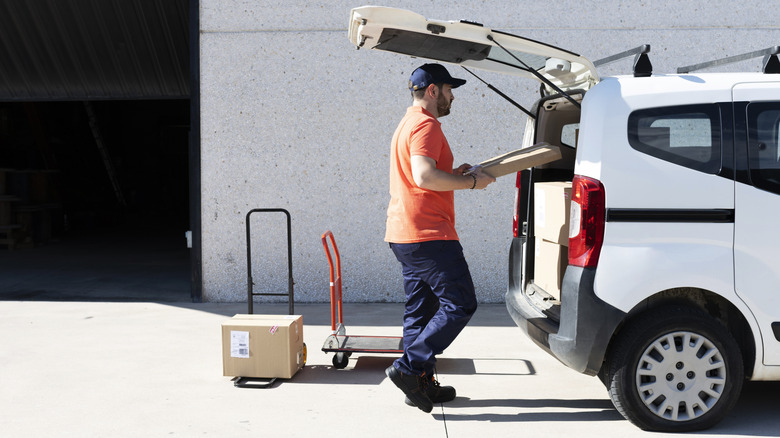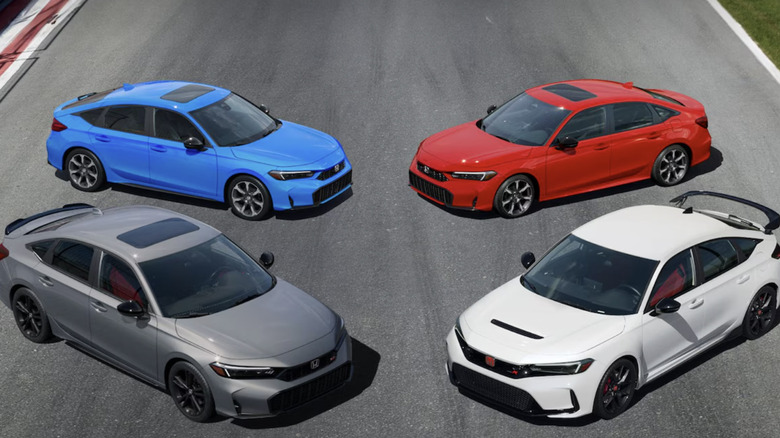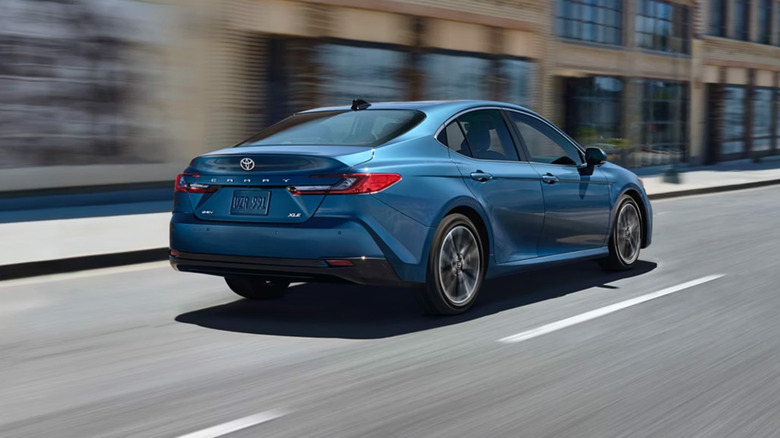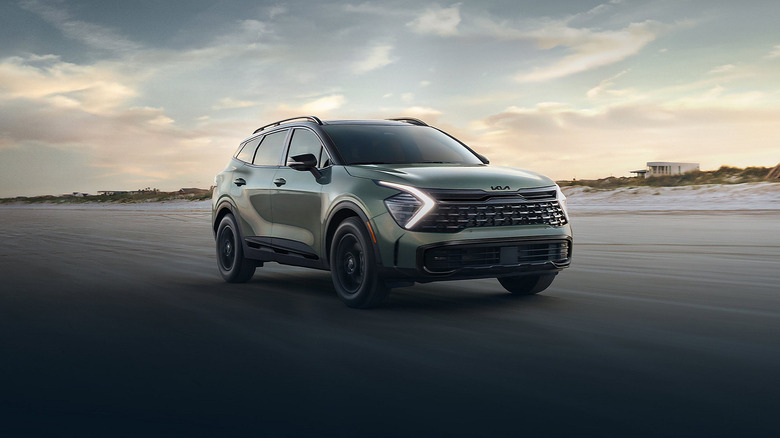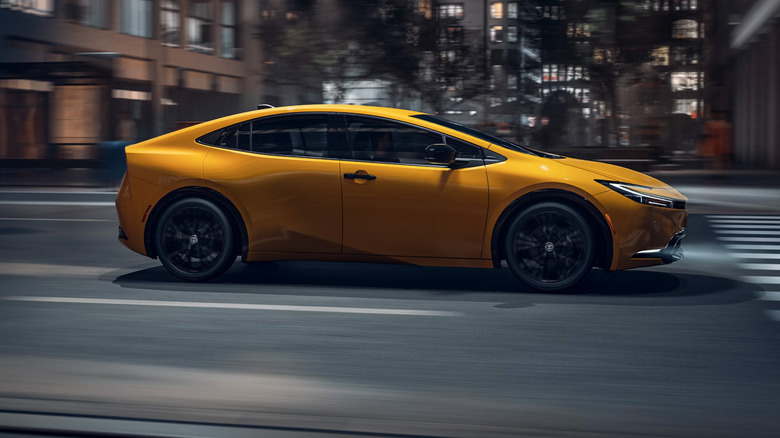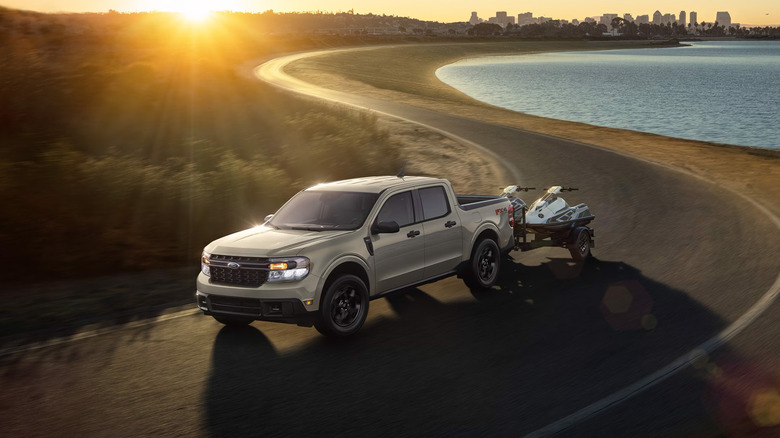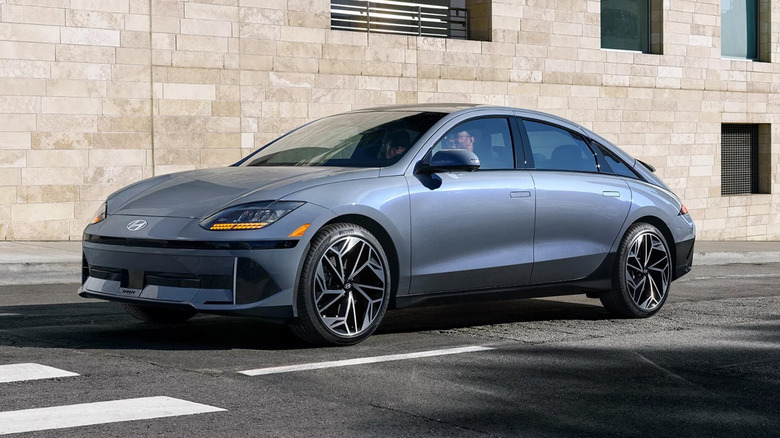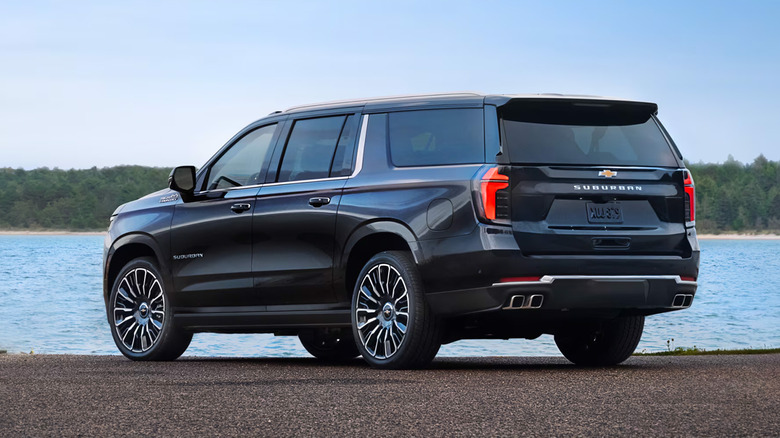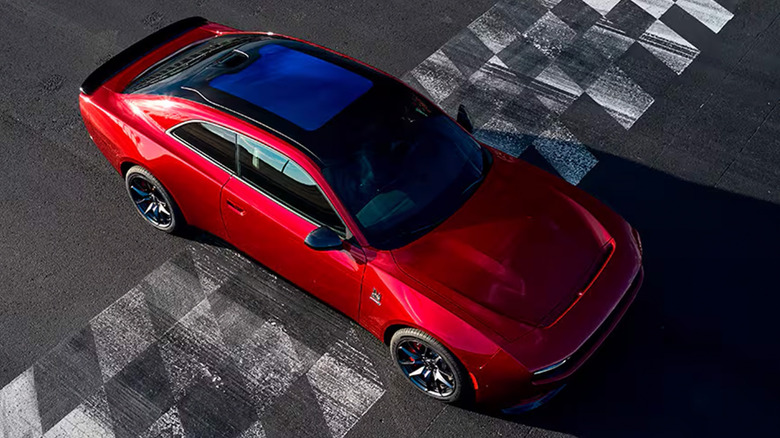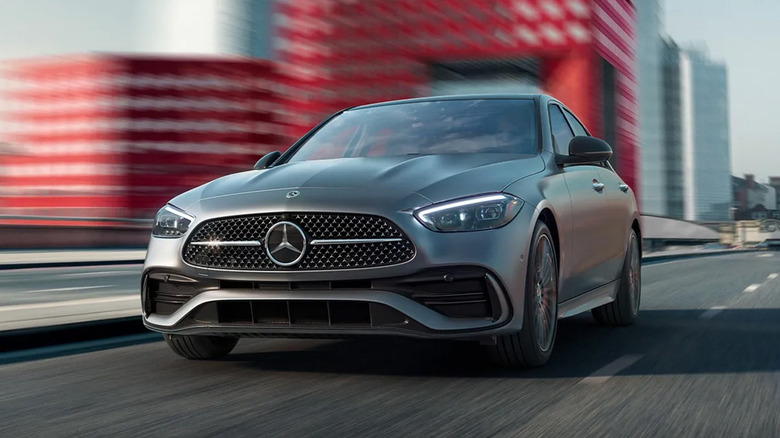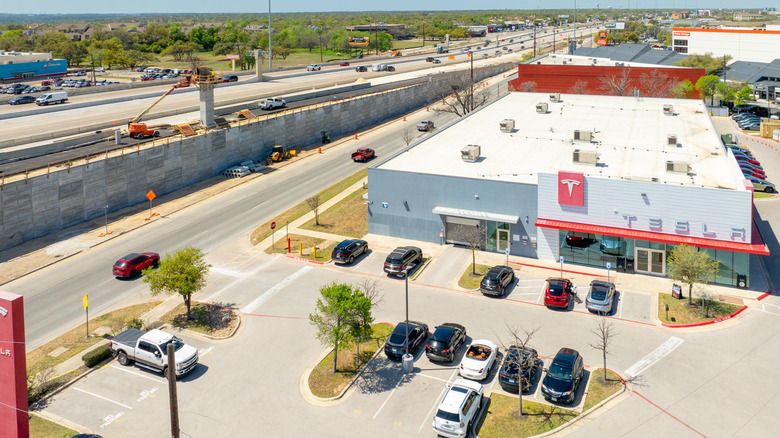10 Of The Best And The Worst Vehicles For Delivery Drivers
Delivery driving is big business these days. The proliferation of food delivery services like DoorDash and Uber Eats mixed with more traditional delivery jobs like pizza delivery and independent Amazon drivers has given people more of a reason to drive for money than ever before. According to the U.S. Bureau of Labor Statistics, over 1.5 million people were engaged in the industry in 2023, and they made a median pay of $39,950 per year. It's also among the fastest growing jobs as more people pile in to deliver food.
As such, it's no surprise that a lot of people are shopping for delivery cars these days. After all, you want a car that maximizes efficiency, minimizes risk, and isn't too expensive to own since all of those things can cut into your profits. Fortunately, there are decades of data to work with since pizza delivery started really taking off in the 1960s. As the Uber Eats of yesteryear, pizza delivery drivers from way back when know a thing or two about choosing cars. That's why I'm writing this article today. In the mid-2000s, I delivered pizzas for Papa John's and later Pizza Hut before I went to seek other pursuits.
So, if you're in the market for a delivery car, here are some ideas on where to look. If you really want the short version — buy yourself a cheap beater with as low miles as possible and use that. It's the best generic starter advice I can give you.
Good: Honda Civic
Let's start with the good old Honda Civic. Honda has been making these for decades and you can find them at virtually any dealership in the country. The little commuter car has quite a history of being peppy and fun while still being considered generally reliable. There are also several different types of Civics to choose from depending on which generation you go with. Those looking to transport longer cargo can opt for a hatchback while your everyday food delivery driver can use the regular sedan.
Here's why Civics are good for delivery driving. Honda is among the cheapest car brands to insure, which is a boon if you're buying one as a secondary delivery car. In addition, Civics have done better than 25 MPG in city driving for most of the last two or three decades, saving you tons of money at the pump. Finally, used Civics are quite inexpensive. In my general area, I was able to find dozens of Civics for under $15,000 with under 100,000 miles. Many of those dipped under $10,000 too. If I were getting back into the delivery game, those sub-$10,000 Civics with under 100,000 miles would be among my first options.
There are other reasons too. Civics are small, fit into tight spaces, and are exceptionally inexpensive to maintain in terms of oil changes and repairs. Other small cars that work well include the Nissan Altima, Kia Forte, Volkswagen Jetta, and Nissan Sentra.
Good: Toyota Camry or Corolla
The Toyota Camry and Corolla have a lot of the same pros and cons as the Honda Civic. They are both inexpensive to buy used, are super popular so they can be found easily, and tend to run for a very long time thanks to Toyota's long-standing reputation for being reliable. Like the Civic, the Corolla has a hatchback model for more unique cargo while the Camry is simply larger overall. Of the two, we'd recommend a Camry over a Corolla, but the Corolla competes with the Civic in terms of affordability, size, and fuel economy.
There are other, smaller reasons why these cars are good as well. Several Camry and Corolla models come with an AWD option, making them a little better in inclement weather than Honda sedans. Of course, the downside to that is that the overwhelming majority of inexpensive Camry and Corolla models are FWD, so there is a trade-off there if you want AWD. Other than that, you have an option between four- and six-cylinder engines depending on which generation you go with and you can, in fact, get a Corolla or a Camry with under 100,000 miles for under $10,000.
Fuel economy for both cars tend to also be good. Corolla models tend to get in the high 20 MPG range for older models and well into the 30s and 40s for newer models. The Camry only does marginally worse, but the latest models are hybrids only and do excellent with fuel efficiency.
Good: Kia Sportage or a Hyundai Tucson
In general, crossover SUVs are just okay for delivery vehicles. They tend, on average, to have worse fuel economy than similarly equipped sedans thanks to heavier weight, more drag, and other factors. However, some delivery gigs like being an independent Amazon driver require you to have more cargo space, so sometimes you have to bite the bullet and get an SUV. For this, a Hyundai Tucson or a Kia Sportage is a decent overall choice.
There are a few reasons for this. First, used Sportage and Tucson models are fairly affordable. You'll want to avoid models from 2011 through 2019 thanks to the Theta II engine controversy, but models from 2020 onward aren't terribly expensive. They have the benefits of an SUV without being terribly large and the base models can get decent — if not great — fuel economy. We recommend avoiding the top end Sportage trims because the turbo-four in that one reduces fuel economy by quite a bit. They are also cheaper to maintain than many crossover SUVs.
There are a lot of decent crossovers for this as well. The Toyota RAV4, Honda CR-V, and even smaller crossovers like the Chevy Trailblazer aren't too bad. You can really go with just about any of them since they're all fairly inexpensive overall. However, the Kia and Hyundai models are competent daily drivers and later models come with a hybrid powertrain, further increasing fuel efficiency. Their wide availability and inexpensive nature make them good for putting around with deliveries.
Good: Toyota Prius
When I was doing deliveries 20 years ago, the Honda Civic or the Toyota Corolla and Camry were the top tier options. These days, the car we found people recommending more than any other was the Toyota Prius, which makes perfect sense when you think about it. The Toyota Prius gets over 50 MPG in the city regardless of if you get one that's 10 years old or one that was released last year. In terms of fuel economy, the Prius is king of the streets, making it excellent for deliveries.
There are other benefits as well. The Prius is as cheap as can be on the open market. It's very common to find a used Prius with well under 100,000 miles for south of $15,000. They're cheap to insure as well, costing less than many comparable vehicles. Repair and maintenance costs aren't quite as low as the Civic and Corolla but it's still pretty good considering there's a whole battery pack in there.
When you put it all together, it makes the Prius an exceptional vehicle for delivery driving. You can even get away with driving in EV mode below 25 MPH as long as the battery has juice, which is a common occurrence for delivery drivers. The only downside is that the car takes approximately one eternity to reach highway speeds, but delivery drivers don't usually need to go that fast.
Good: Ford Maverick
We could keep listing mid-size and small sedans all day, but I think we've driven that point home — pun squarely intended. So, let's look at something a little bit different. The Ford Maverick is an interesting truck because it's built for efficiency and day-to-day use rather than hard work like most pickup trucks over the years. This suburban-friendly truck is built similarly to the Honda Ridgeline and Hyundai Santa Cruz in that it's really more of a crossover SUV with a truck body.
This gives it some advantages. For starters, it rides pretty nicely, which is important if you're going to be in it all day delivering stuff. The cab has two rows, so you can still use it to deliver food and all of that. However, you get the added benefit of a truck bed in case you need to haul something larger. It also does better than any other non-EV truck in fuel economy, boasting 26 MPG combined on the base engine and up to 37 MPG combined with the hybrid powertrain. This means you're getting crossover SUV or old Honda Civic fuel economy numbers in a truck form factor.
It's also one of the least expensive trucks on the market. You can get one with low miles and in great condition for a hair over $20,000. If you shop the sales well enough, you can get a base model Maverick brand new for around that much as well. It's not as cheap as the economy cars above but it's the only truly decent truck for delivery driving.
Good and bad: EVs
EVs are in a unique space for this segment. On the face of it, they seem perfect for delivery driver work. Compared to regular gas engines, the amount of power an EV uses while at idle is negligible, reducing the number of times you have to recharge the thing versus heading to the pump with an ICE vehicle. In addition, just about every EV either comes with AWD by default or it can be added as an option. The efficiency and capability make it perfect for delivery work.
However, there are some setbacks too. EVs tend to be much more expensive than hybrid or gas cars. Plus, other than Tesla, most automakers have only been making EVs for a few years, so you won't find many EVs at ultra-affordable prices like you can the Corolla, Altima, or Civic. Maintenance costs over the first three years are similar to gas-powered cars without taking the EV tax credits into account, which is important since these only apply to new car purchases anyway. With that said, EVs tend to be less reliable overall, leading to a higher risk of repair as the EV ages.
That makes this one a toss-up for us. There are plenty of EV options on the market these days, and they are getting less expensive every year. Even so, the good ones still start at $40,000 or more brand new and used ones in good enough condition to drive for delivery rarely dip under $20,000. The choice is yours.
Bad: Large SUVs
When it comes to delivery driving, large SUVs are probably not what you want. By large, we mean vehicles like the Chevy Suburban, Kia Telluride, and Ford Explorer, among others. The reasons are vast, so we'll go through the easy ones first. They're huge and therefore don't fit well in tight parking spaces. Most of them guzzle gas like nobody's business as well. Some, like a late model Ford Explorer, can eke out just a hair over 20 MPG in the city with its most fuel-efficient engine, but the overwhelming majority do less than 20 MPG in the city.
Once you get into the weeds, the story doesn't get much better. Large SUVs tend to be more expensive on the used market. For example, the cheapest Kia Telluride within 50 miles of me is $18,000 and has 90,000 miles on it. That's for the base model with front-wheel drive. Not the worst deal, but I was able to find multiple 2020 Honda Civics within 50 miles of me for the same price with as little as 55,000 miles and 50% better fuel economy.
Large SUVs are also more expensive to maintain on average. This can vary wildly, but a Chevy Suburban costs $944 per year to maintain according to RepairPal. That's nearly three times what it costs to maintain a Civic or a Corolla. You can absolutely deliver with these vehicles, but you're paying a lot more for it than someone who opts for something else.
Bad: Sports cars and muscle cars
Have you ever seen someone making Uber Eats deliveries in a Ferrari? There's a reason so few people choose sports cars and muscle cars for delivery driving. Somewhat ironically, it's much for the same reason a lot of folks don't recommend large SUVs — sports cars and muscle cars tend to have abysmal fuel economy. The Porsche 911 Turbo gets around 18 MPG in the city, while the Turbo Coupe gets around 14 MPG. Dodge Chargers can get as low as 12 MPG in the city.
Fuel economy is the big issue, but it gets deeper than that. Sports cars and muscle cars are simply more expensive. You can buy approximately eight brand new 2025 Honda Civics for the price of one Porsche 911 Turbo. The annual repair and maintenance cost of a Ford Mustang is roughly double that of a Toyota Corolla. It doesn't matter where you throw the dart, sports cars and muscle cars are simply more expensive to purchase, own, insure, and drive than their economy car counterparts.
This matters a lot because delivery driving is a lot about balancing your costs versus your income. If you bring in $300 in a day delivering DoorDash, you'll end up putting more of that into a sports car. It especially hurts when you have to fork out $5,000 for an Audi RS7 headlight assembly.
Bad: Luxury cars
Luxury cars aren't much better than sports cars for delivery work. They cost more to purchase and insure than economy cars while maintenance costs are similarly high. Per RepairPal, a Mercedes costs around $900 per year to maintain and repair. That's nearly two and a half times as much as a Toyota Corolla. Like we said earlier, delivery driving profits are based heavily on how much you have to spend on your most important tool and luxury cars are right up there in terms of price.
However, there are some caveats here. Luxury cars span a fairly wide price range, so it really depends on which ones you choose here. For example, Lexus maintenance costs aren't all that much higher than non-luxury automakers. You can find something like a 2016 Lexus ES Hybrid 300h — which is a hybrid model — for under $20,000 and with under 100,000 miles on occasion. That gives you luxury car chops, 40 MPG combined, and a decent used car price, making it not so bad for delivery work. However, examples like this are few and far between, so shop wisely.
If you really want to deliver Taco Bell in the lap of luxury, Lexus and Acura are your best bets. They're less expensive than a Mercedes or Genesis and they cost less to maintain. We still think a hybrid Camry is a better value for delivery driving, though.
Bad: Brand new cars
You may have noticed that up to this point, I have been referring to used cars when it comes to delivery driving. There is a reason for that. New cars are nice. That fresh car smell mixed with driving off the lot with less than 10 miles on the odometer is a good feeling. It's great if you intend to keep a car for many years because you can personally make sure that the car gets all of its maintenance, and you know exactly how the car is going to be driven.
For delivery driving, getting a used car is the more sensible option. Used cars are far less expensive than new cars. You can find plenty on the market for far less money, reducing your monthly payments. There are other benefits too. Cars lose their value pretty quickly once they're driven off the lot whereas used cars tend to depreciate in a more linear fashion. You can also finance a used car easier even if you don't have stellar credit, getting you on the road and making money sooner.
The biggest thing is insurance. Used cars cost less to insure than the same car that's brand new. That's a boon for delivery drivers since insurance companies don't tend to insure delivery vehicles the same way as personal vehicles. You can definitely use a new car for deliveries, but you'll save a ton of money buying used.
More general tips for delivery car shopping
In general, any car works as a delivery vehicle if you really want it to, even gas guzzlers like the Chevy Suburban or the Dodge Charger. However, as you've no doubt seen, the best general advice is to buy a cheap used car that is good on miles and fairly reliable like offerings from Honda and Toyota. From there, deliver with it until the car dies and then move to the next one. Delivery driving is rough on cars thanks to the near-constant idling and city-only driving that drivers deal with most of the time.
So, try to find something cheap that doesn't cost a lot to insure and is easy on the fuel. That's why so many people choose something like a Prius or Civic. The less you spend on the car payment, insurance, and gas, the more money goes home with you. In fact, in some cases, a delivery car isn't even the best option. In some situations, electric scooters are superior. They're even smaller, even cheaper, and they can weave in and out of traffic in busy places like New York City or if you're delivering short distances in safe areas like a suburbia.
So, regardless of what you choose, keep your costs in mind. How much you spend on your vehicle will directly correlate to how much money you bring home. Good luck!
